

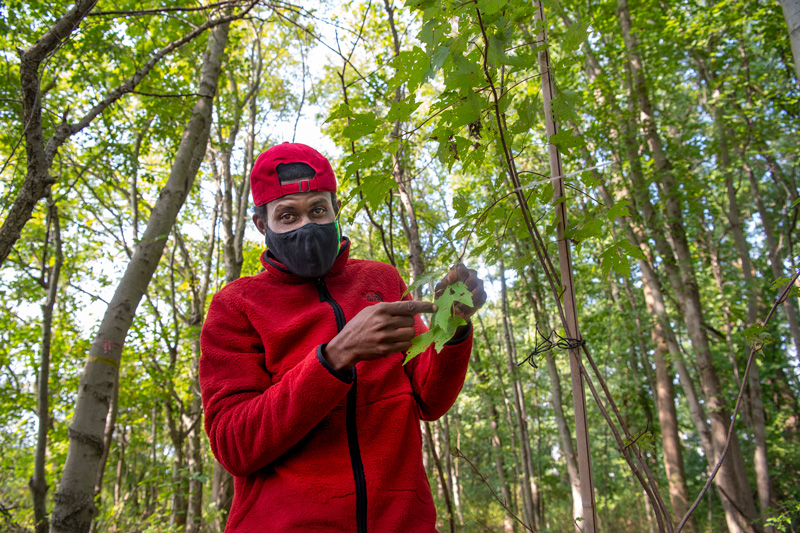
Force of nature
Photos by Kathy F. Atkinson and courtesy of Covel McDermot October 09, 2020
UD researcher Covel McDermot studies red maples in urban forests
If we would only listen we would hear. The trees are speaking. That’s the philosophy of Covel McDermot, a recent alumnus of the University of Delaware’s College of Agriculture and Natural Resources who devotes his research to the study of urban forests.
McDermot recognizes trees as important biomonitors, capable of indicating the health of a city and, by extension, the city’s inhabitants. Plants store many years of functional information that can be used to explain relationships, patterns and environmental changes, especially in urban systems. This knowledge is necessary to better assess the health of green cities around the globe.
In a study recently published in PLOS One, McDermot and a team of researchers — including his former adviser Tara Trammell, UD’s John Bartram Assistant Professor of Urban Forestry — studied red maple, a resilient native tree known to thrive in urban environments. For this research, McDermot examined whether urban red maples acclimate to environmental shifts and whether that response is impacted by the size of the city.
“We have different levels of nitrogen deposition due to fumes from vehicle tailpipes, construction materials are adding excess calcium into forest soils, carbon dioxide levels are elevated because of population density, and we have impervious surfaces like roads and buildings that are holding heat and warming up the city in a phenomenon we call urban heat island,” said McDermot. “Our goal was to evaluate health and stress-indicating compounds in the leaves of red maple trees that face these conditions in forests embedded in a large, heavily urbanized city versus a small, fairly urbanized city.”
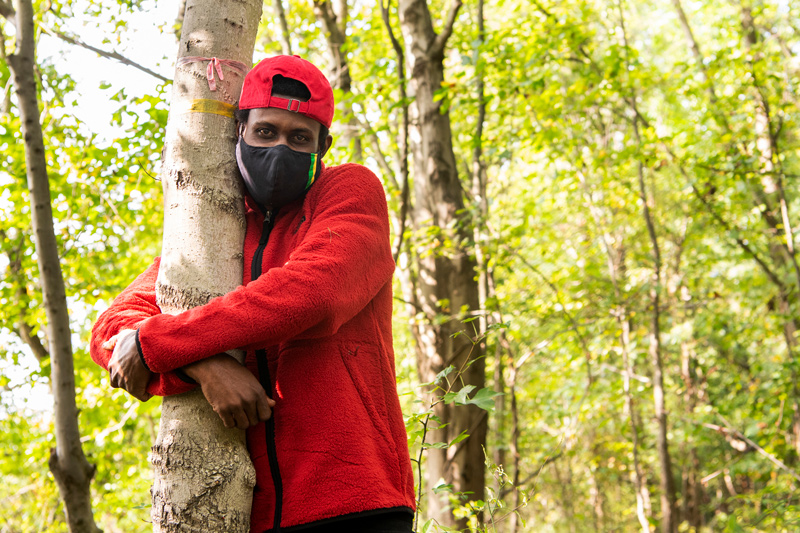
To determine how trees respond to different urban intensities, the team compared forests in Newark to those in Philadelphia. In forest fragments that make up the FRAME network in each city, data was collected to measure tree size and age, foliage nitrogen signature, nutrient and heavy metal content, and stress-responding metabolites, as well as surrounding soil conditions.
Not only were the trees acclimated to urban conditions but the red maples in the higher density Philadelphia forests were actually healthier and more productive than those surrounded by less urbanization in Newark.
“Starting out this project, I made an educated guess that the excess nitrogen found in larger cities would spur productivity in these trees by acting as a food source and that hypothesis was accepted here. I also believed that the combined urban heat island, elevated nitrogen deposition and higher nutrient loads in the larger city can result in a physiological shift in tree species to make them more tolerant to the contrasting environmental conditions,” McDermot said. “People usually think that urban ecosystems are nutrient deficient, but we see that these systems have higher nutrient loads that support productivity.
“For example, in Philadelphia there is a lot of construction using concrete. Concrete is a substance that contains calcium, magnesium and aluminum. As construction and deconstruction happen, as they often do in cities, these materials eventually break down and become available food sources for plants. Look at your wall. It’s likely made of materials containing gypsum and those will eventually end up in the soil and become bioavailable to plants.”
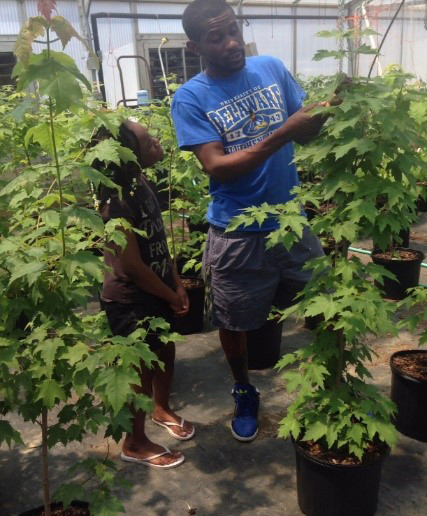
To build barriers to stressors like excessive heat or heavy metals, trees produce stress-shielding and signaling compounds which protect the chloroplast and mitochondria from oxidative stress, allowing the tree to flourish. However, there is a tradeoff in resources for growth and development versus permanent stress defense. Philadelphia soil conditions, unlike those in Newark that experienced degradation due to past agricultural practices, were more nutrient rich so those ecosystems held enough nitrogen to allow trees to produce additional stress-responding compounds while also growing into healthier, more productive forests.
McDermot hopes that this red maple study serves as the blueprint for future research on other species commonly found in urban systems.
“This gives us insight into planting the right trees in cities,” McDermot said. “We can’t just focus on beautification. We need to support ecological resilience. It’s about prescribed greening — planting the right tree species, in the right place, in the right soil conditions and for the right reasons.”
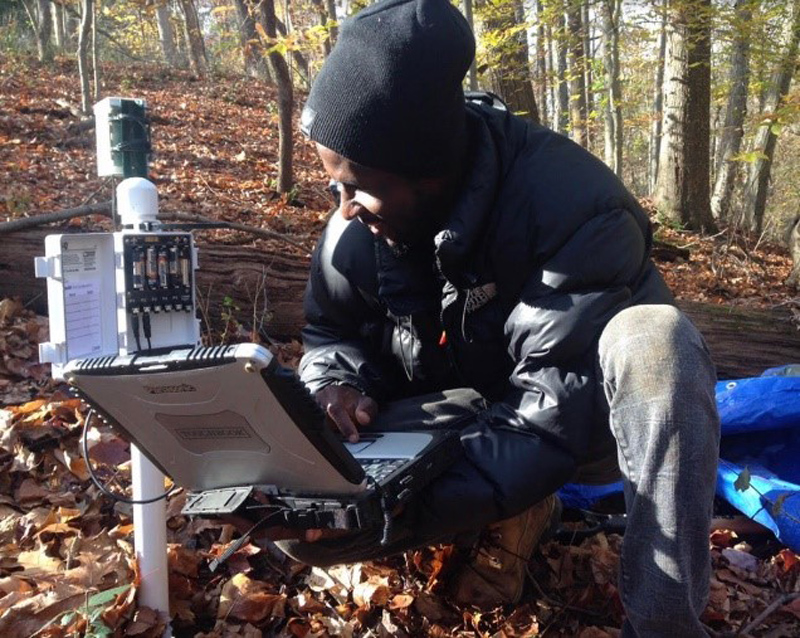
He also says that understanding the health of city trees and forests, and the ways in which they process nutrients and toxins, can impact how we understand and address public health in cities. By sequestering excess nitrogen and carbon dioxide, healthy trees make our cities cooler and our air purer. They hold water in the soil making our cities less humid. Trees act as phyto-extractors, removing heavy metals from our soils where we plant crops giving us cleaner food. They provide shade to our homes resulting in lower utility bills and lower energy consumption.
“In my view, there is a direct correlation between plant and human health and environmental quality,” said McDermot. “Show me a forest and I can tell you about the health of the city and it’s communities.”
McDermot earned his doctorate in plant and soil sciences in 2019 and practiced as an urban ecologist in Tara Trammell’s lab after graduation, but he considers himself a chemist at heart. He holds a bachelor's degree in general chemistry from the University of the West Indies in Jamaica and an associate degree in natural sciences from the College of Agriculture, Science and Education in Port Antonio, Portland in Jamaica. He also earned a master’s degree in agriculture science from Delaware State University in Dover, Delaware. Urban forestry allows him to experience the best of these worlds.
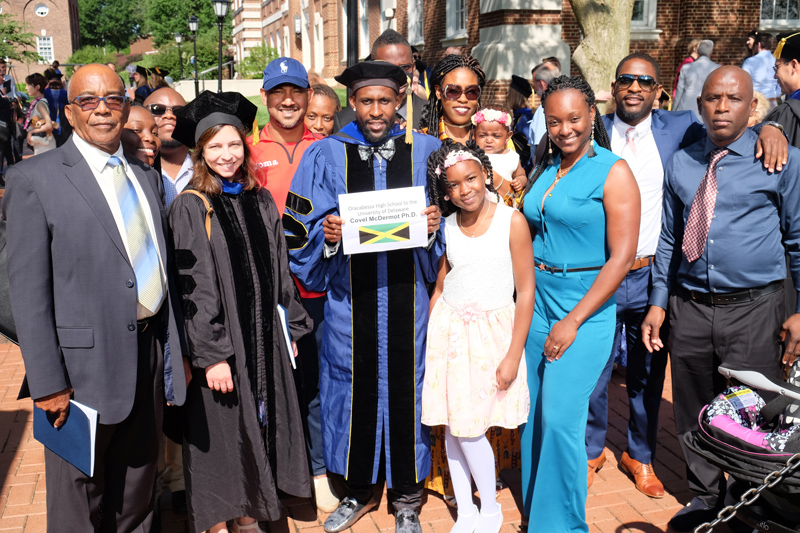
“I like to talk about the physiology and biochemistry of trees and soil patterns because I am still using my foundational knowledge to assess these compounds, identify mechanisms and describe processes in urban ecosystems,” McDermot said. “For the analysis — whether it’s extracting compounds or cleaning up compounds — I have the chemistry background to do that. I have a green thumb so I enjoy growing and caring for plants. All of those skills are easily transferred to urban ecosystems. It’s just about me putting the pieces together.”
McDermot plans to continue working on manuscripts with his former adviser and collaborating with UD colleagues. He began his first postdoctoral research associate position this fall with adviser Venu Kalavacharla in the College of Agriculture, Science and Technology at Delaware State University.
Contact Us
Have a UDaily story idea?
Contact us at ocm@udel.edu
Members of the press
Contact us at 302-831-NEWS or visit the Media Relations website

